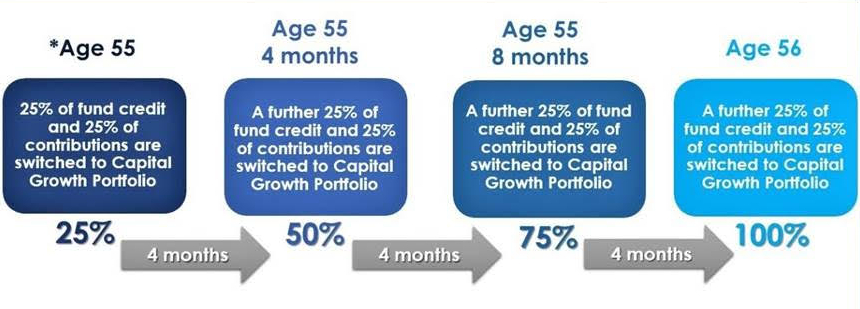Investments
Life stage (default)
The fund applies a life stage model which automatically takes members through different investment portfolios i.e. aggressive to more conservative portfolios as they near retirement age. The life stages are as follows:
- Members younger than age 55 - Aggressive Growth portfolio
- Members age 55 and older, but younger than age 62 -Capital Growth portfolio
- Members age 62 and older - Stable Growth portfolio
The fund has implemented a phasing-in approach for default switches. Read more
The first 25% switch to the new recommended portfolio will commence at the end of a member’s birthday month. As a result, it will take 12 months for a total portfolio switch to be completed. After the 12 month phase-in period, all future member contributions will automatically accrue to the new default life stage portfolio. See an illustration of a default switch from the Aggressive Growth portfolio to the Capital Growth portfolio below.

*The first 25% switch to the new recommended portfolio will commence at thee end of a member's birthday month.
Member investment choice
The fund also allows flexibility in providing our members with the option to elect any of the individual investment portfolio options available.
Investment switch form
Aggressive Growth Portfolio
Investment objective: To maximise capital growth over a long-term investment horizon. Members should acknowledge that this strategy could deliver volatile and negative returns over the short-term. This strategy is suitable for members with more than 10 years to retirement.
Capital Growth Portfolio
Investment objective: :To target capital growth over a medium to long-term investment horizon. Members should acknowledge that this strategy could deliver volatile and negative returns over the short-term. This strategy is suitable for members with 5 to 10 years to retirement.
Stable Growth Portfolio
Investment objective: To target stable returns over a medium-term investment horizon with low volatility and a low probability of negative returns. This strategy is suitable for members with 1 to 5 years to retirement.
Capital Protector Portfolio
Investment objective: To provide capital security with very low volatility and an extremely low probability of negative returns. This strategy is suitable for members with less than 1 year to retirement where capital protection is absolutely necessary
Shari’ah portfolio
This portfolio is suitable for Muslim investors requiring a Sharia-compliant investment portfolio. The portfolio will be invested in a variety of domestic and international asset classes. The underlying investments will comply with Shari'ah requirements as prescribed by the Auditing Organisation for Islamic Financial Institutions. The portfolio targets capital growth over the long-term while limiting short term market fluctuations.
Latest investment returns

Economic Commentary: June 2025
Global markets maintained positive momentum in June, as trade tensions eased and a spike in geo-political tension quickly subsided.
In the US, inflation rose less than expected in May (+0.2% m-o-m) with the annual rate increasing slightly to 2.4% in May from 2.3% in April. The ultimate effect of tariffs has yet to show in the data and investors are hoping for further clarity on 9 July. The consensus expectation is that US weighted tariff will settle in the “teens,” but that the composition of tariffs will evolve over time as negotiations continue. There are however signs that the US economy is slowing. Q1 GDP was revised down to a 0.5% contraction as consumer spending was revised down to just 0.5% from 1.2%. This trend of weaker consumption persisted into May as consumer spending fell 0.3% month-on-month compared to expectations for a 0.1% rise. New home sales, another leading indicator of economic activity, were 14% lower in May than in April and new housing inventory is now at the highest level since 2007. With much of the US’ wealth linked to housing, and consumption responsible for 70% of GDP, a trend reversal in these two measures, and continued concerns about the robustness of the jobs market, does not bode well for business conditions for the rest of the year. Meanwhile, the US Federal Reserve kept interest rates unchanged in June but raised its forecast for inflation and lowered its outlook for economic growth in 2025. Fed Chair Jerome Powell noted that increases in tariffs are likely to boost prices, adding that the effects on inflation could be more persistent.
Global investors reacted positively to trade policy developments, including a temporary pause in tariff escalations, seemingly ignoring the ongoing risks from tariffs and inflation. Market leadership reverted to economically sensitive US technology and consumer stocks at the expense of European industrial stocks. The MSCI World Index ended the month with gains of 4.3% driven by gains in Information Technology, Communication Services, and energy stocks. The S&P500 ended the month with gains of 5.1% while the NASDAQ rallied 6.3%. Germany’s DAX declined 0.4% as investors were cautious ahead of the previously-announced 9 July tariff deadline, while Japan’s Nikkei Index surged 6.8%. Emerging markets outperformed developed markets with gains of 6% as US dollar weakness combined with improved sentiment towards Chinese stocks amid an easing of trade restrictions. Exporting nations like Korea, Brazil and Taiwan were top performers, while Argentina, Indonesia and Thailand lagged. Global bond markets gained 1.9% as the yield on the 10-year US Treasury fell slightly to 4.25% at month end as the US Federal Reserve left interest rates unchanged and an increasing number of members believe that rate cuts are no longer appropriate given the anticipated trajectory of inflation. Global property stocks gained 0.8% as continued high funding rates dampened enthusiasm towards the sector.
In South Africa, Q1 GDP rose a meagre 0.1% – in line with the Reserve Bank’s forecast – as a 15.8% increase in agriculture and 2.4% growth in the transport, storage, and communication sectors was offset by large declines in manufacturing (-4%) and mining (-2%). Household final consumption expenditure also increased, contributing 0.3% to the overall growth, but this was offset by a decline in gross fixed capital formation and lower government expenditure. Inflation meanwhile held steady at 2.8% year-on-year, unchanged from April, with core inflation also unchanged at 3.0% year-on-year in May. Business confidence was stable, and consumer confidence likely improved as new vehicle sales rose for the second consecutive month and households benefited from lower borrowing costs.
Local equity markets lagged emerging markets as gains in resources stocks were offset by losses in retailers and domestic industrials. The All Share Index gained 2.4% for the month (+10.2% for the quarter and 16.7% YTD) driven by a 4.2% gain in resources stocks as platinum miners rallied as the price of platinum gained 30% on the back of increased imports from China and fears of a sustained supply deficit. Industrials stocks gained 2.4% in aggregate driven by a 7% gain in Naspers, while financials added 0.8%. The rand strengthened 1.7% for the month (3.4% for the quarter), despite renewed fragility in the GNU as investors welcomed talk of a lower inflation target. Local bonds gained 2.3% for the month (+5.9% for the quarter) as prospects for South Africa’s removal from the FATF grey list improved. Listed property stocks however declined 0.9% in June (but gained 9.1% for the quarter) as disappointing results dampened sentiment and investors took profits after a strong rally.
 NFMW AG FFS June 2025
NFMW AG FFS June 2025
 128 kb
128 kb
 NFMW CG FFS June 2025
NFMW CG FFS June 2025
 125 kb
125 kb
 NFMW SG FFS June 2025
NFMW SG FFS June 2025
 154 kb
154 kb
 NFMW CP FFS June 2025
NFMW CP FFS June 2025
 132 kb
132 kb
 NFMW Sharia FFS June 2025
NFMW Sharia FFS June 2025
 146 kb
146 kb
Investment policy statement
Investments FAQs




 Cookie Notice
Cookie Notice Cookie settings
Cookie settings